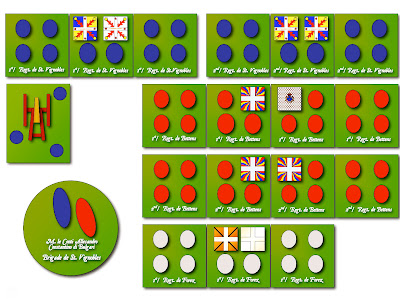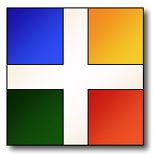The continuing tale of the Chevalier de St. Estampie-Galliard from the pen of his commanding officer, M. le Marquis de Sangfroid himself;
********
"After a few more fortifying glasses of claret, I felt myself able to explain to my confidant M. de Brouillier the reason that lay behind my apparent change of mood, and told him of what I knew of M. le Chevalier de St. Estampie-Galliard, the relating of which would certainly enlighten him to the source of my present distress.
The family of St. Estampie-Galliard is an ancient one from the lands of Roussilon, and while, of course, not of such august a lineage as that of the Bouillon-Cantinats, their service goes back many generations to the time of the Angevins.
The chevalier's father was of a man of some renown in the late wars in Spain alongside the great Marshal Berwick, in the course of which he met his future wife, the present chevalier's mother. She was a lady of ancient noble Spanish blood, who was renowned in her youth for her passionate nature and great beauty- as well as, it is said, for her somewhat lax moral character; a trait which, it must be noted, has evidently been passed on down to her son.
The chevalier is reputed to be quite handsome, and to his merit he is a fine rider and judge of horseflesh. Of his courage there is no doubt. Alas, the same cannot be said of his providence, perseverance nor especially of his judgement as it pertains to matters of a non-equine nature.
I had the opportunity once to conduct mass wherein the good chevalier was in attendance. The occasion remains in my remembrance on account of noting his frequent lack of concentration, consistent and loud yawning, and his insistence of taking up of conversation with the more attractive ladies of the congregation during my remonstrance against the evils of indolence and gluttony.
His good looks, athletic prowess, and considerable charm have served to further him in his career where otherwise his lack of mental agility and self-discipline would have disbarred him. Of late he had been serving in the Maison du Roi, with the Gendarmes Bourguignons du Roi. But evidently he has been showing fealty more to the Goddess Venus than to warlike Mars, which seems to have been the root cause for his current lack of employment.
It is reported, amongst those who have a taste for such snippets of knowledge and rumours, that the aged but most revered and influential of chancellors, M. le Duc du Cressé-Armagnac, had a very young and beautiful ward who was known to be a favourite of our King Louis.
Mlle. Hortense-Desirée de la Cloche-Rohan enjoyed a reputation throughout the court at Versailles for being a gentlewoman of singular beauty of complexion and fullness of figure, and she was much admired by the men of court, young and old. Thus when the opportunity arose, during the course of a dinner given in honour of the Conte d'Arles, it was upon this young enchantress who had evidently captured his attentions that our chevalier was to ply all the considerable talents for wooing and of charm that he had at his disposal."

"It appears that the chevalier's first real campaign was crowned with success and that the object of his besiegement surrendered the citadel- and all its more intimate chambers- without demur. Unfortunately for M. Le Chevalier, he was discovered engrossed in the act of intense exploration of his newly-conquered possessions by the Duke himself, who had descended into the wine cellar in company along with his companions, M. l'Abbe d'Eu and M. le Marquis de Feltres- who also happened to be the commanding officer of the Gendarmes Bourguignons du Roi-, intending to surprise these respected gentlemen with a cache of fine wines, which he had had the fortune to acquire in the course of a recent journey to Dijon.
That it was indeed a surprise to all involved is not in dispute.
The resulting fracas saw the benevolence and serenity of His Majesty sorely tested to the fullest, and it is rumoured that were it not for the timely intervention of the Queen- who had taken a liking to our now somewhat compromised hero- the worthy chevalier may by now have found himself in the service of the Ministry of Marine in New France. Instead, it was determined that he would be sent far from the centre of court to the armies currently serving on the frontiers either of the Rhine or of Piedmont-Savoy, in order that he may have to chance to redeem himself with his monarch through some act of heroism or other.
So it can be seen that Lady Chance is a fickle mistress, and thus it had fallen to my lot to provide a station in life for this unfortunate wastrel.
As the day went on, the thought of entrusting such a fine brigade of horse to a man of so little proven ability in matters of administration and tactics troubled my staff and I immeasurably. While no doubt ultimately having to accept the appointment, I determined that I would lever certain advantages from the arrangement.
Namely, I wanted a trusted second-in-command for the brigade, so I petitioned the Minister that I have the Regt. de Bouillon-Cantinat take precedence over the other regiments of the brigade, by recognizing it as a legitimate successor to its forbears in 1688.
Thus the brigade would bear it's name, and the major of the Regt. de Bouillon-Cantinat- my trusted and experienced subordinate from St. Vignobles itself, M. le Chevalier Eduard Duchamps de Botte-en-Selle- would through his position as brigade chief-of-staff prevent the Chevalier d'Estampie-Galliard from ruining the brigade through either neglect or excess.
The minister was only too glad to oblige to such terms, being thankful of having such a tedious conundrum removed from his hands. As for the chefs of the regiments of Clermont and of Conti, they showed themselves quite understanding of the situation, and in exchange for a few barrels of the choicest reserve cognacs from the wineries of St. Vignobles as well as the writing off of certain debts they had owing to me in the course of some ill-fated games of chance, they were content to acquiesce to such an extraordinary departure from the rules of precedence for the sake of the betterment and security of the Service."

























